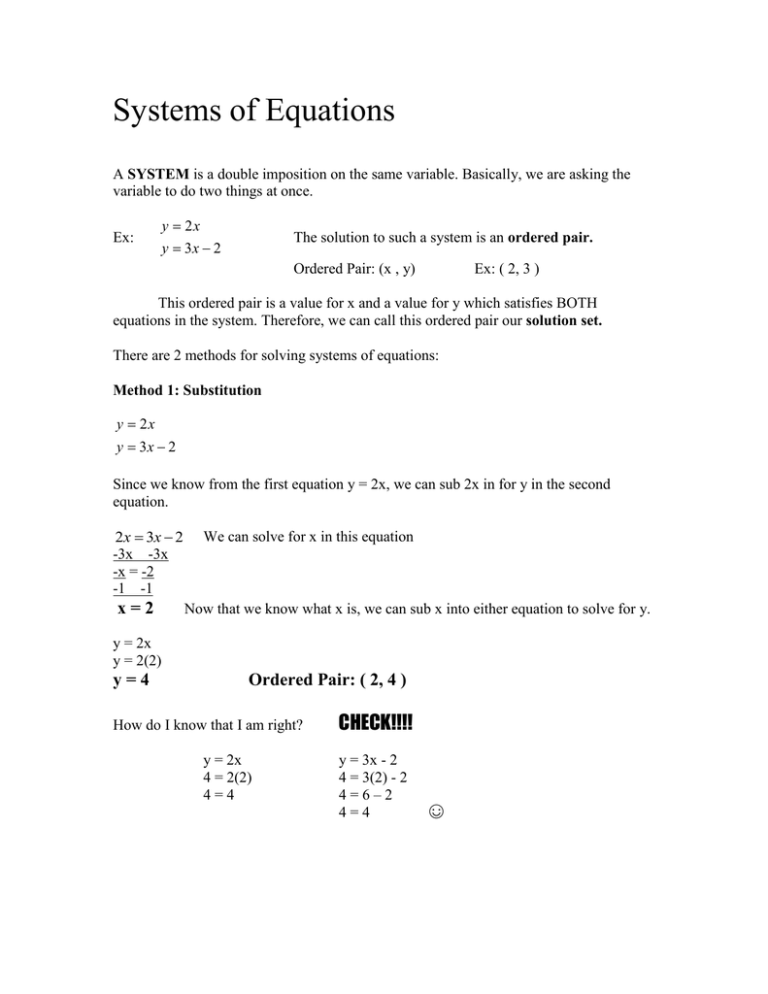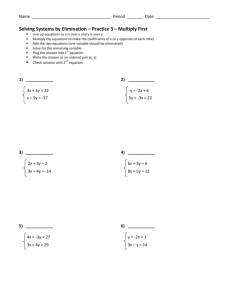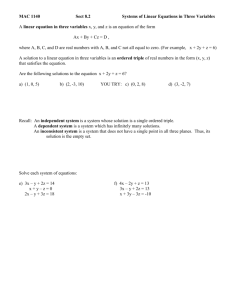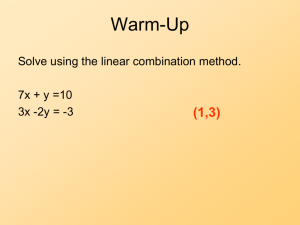Systems of Equations
advertisement

Systems of Equations A SYSTEM is a double imposition on the same variable. Basically, we are asking the variable to do two things at once. Ex: y 2x y 3x 2 The solution to such a system is an ordered pair. Ordered Pair: (x , y) Ex: ( 2, 3 ) This ordered pair is a value for x and a value for y which satisfies BOTH equations in the system. Therefore, we can call this ordered pair our solution set. There are 2 methods for solving systems of equations: Method 1: Substitution y 2x y 3x 2 Since we know from the first equation y = 2x, we can sub 2x in for y in the second equation. 2x 3x 2 -3x -3x -x = -2 -1 -1 x=2 We can solve for x in this equation Now that we know what x is, we can sub x into either equation to solve for y. y = 2x y = 2(2) y=4 Ordered Pair: ( 2, 4 ) How do I know that I am right? y = 2x 4 = 2(2) 4=4 CHECK!!!! y = 3x - 2 4 = 3(2) - 2 4=6–2 4=4 ☺ Ex: yx y 2x 4 x = 2x – 4 y=x -2x -2x -x = -4 -1 -1 x=4 y=4 ( 4, 4 ) CHECK: y=x 4=4 y = 2x - 4 4 = 2(4) – 4 4=8–4 4=4 Want to practice? See your workbook, p. 98, and work on the second and third column =) Method 2: Elimination Solving one equation is always easier than solving two. We can actually re-write one of our equations in the system so that when the equations are added together, one of the variables is canceled out, and we are once again only solving for one variable at a time. Ex: + x y 3 x y 1 If I add equation 1 to equation 2, my y’s will cancel. 2x = 4 2 2 x=2 Now that we have a value for x, we can plug it into either equation to find y. x+y=3 2+y=3 -2 -2 y=1 ( 2, 1 ) CHECK: x+y=3 2+1=3 3=3 x–y=1 2–1=1 1=1 Practice: Workbook, p. 99 ________________________________________________________________________ Sometimes, it isn’t always this easy (I’m very sorry). We may need to make a few adjustments to one, or both, of our equations in order to make sure one of the variables is eliminated upon addition. 2x y 5 If we add these as they are, neither of our variables will cancel. x y 4 If you look closely, the y’s COULD cancel, if only one of those y’s was negative. So let’s do just that. Let’s make the y in equation 2 negative. Ex: 2x + y = 5 -1 ( x + y = 4) NOTICE: I am going to multiply the ENTIRE EQUATION by -1 so that I do not change the value of the equation. 2x + y = 5 -x - y = -4 x=1 Plug x into either equation to solve for y. 2x + y = 5 2(1) + y = 5 2+y=5 -2 -2 y=3 ( 1, 3 ) CHECK: 2x + y = 5 2(1) + 3 = 5 2+3=5 5=5 x+y=4 1+3=4 4=4 Practice on p. 99 in the workbook What do you do when your choice of eliminated variable is not so apparent? MAKE A CHOICE! Whichever variable you want to eliminate will decide how you multiply one (OR BOTH) of your equations. Ex: 2 x 5 y 34 x 2 y 14 2x + 5y = 34 -2(x + 2y = 14) CHECK: I would like to eliminate the x’s, so I will multiply equation 2 by -2 ----- 2x + 5y = 34 2(14) + 5(0) = 34 34 + 0 = 34 34 = 34 2x + 5y = 34 -2x – 4y = -34 y=0 x + 2y = 14 14 + 2(0) = 14 14 + 0 = 14 14 = 14 x + 2y = 14 x + 2(0) = 14 x + 0 = 14 x = 14 ( 14, 0 ) What if we need to adjust both equations? Ex: 2x y 5 5 x 2 y 17 In this example, I know I can’t just multiply one equation because 2 is not a factor of 5. Therefore, if I pick the variable I want to cancel out, and find the LEAST COMMON MULTIPLE of their coefficients, I can multiply each equation in such a way as to have the LCM as my coefficient in front of the common variable. I want to cancel the x’s. Using 2 and 5 as my coefficients, I know I have an LCM of 10. Therefore: 5(2x – y = 5) -2(5x + 2y = 17) Notice one of the multiplications must be negative for the cancel 10x – 5y = 25 -10x – 4y = -34 -9y = -9 -9 -9 y=1 2x – y = 5 2x – 1 = 5 +1 +1 2x = 6 2 2 x=3 Now, when we add the expressions together, x cancels. ( 3, 1 )



